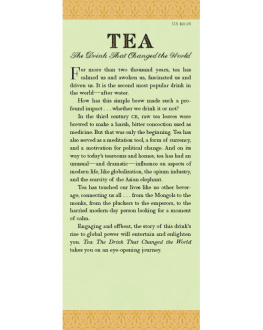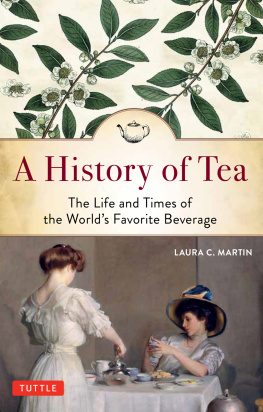APPENDIX A
TEA-GROWING COUNTRIES
CHINA
Chinas tea production is legendaryliterally. There are rumors and stories of Chinas sacred gardens, whichfor hundreds, if not thousands, of yearsproduced teas just for the emperor and his court. Today, special teas are grown and produced just for the highest-ranking party officials. No visitors are allowed in these most sacred gardens, and nothing is permitted that might compromise the purity of the tea. Some of the legendary teas produced in such gardens include Pei Hou, a green tea purported to grow in a tea garden only reached by a five-hour trek.
Whether the leaves are picked by virgins in white gloves or by workers toiling in the vast tea gardens in China, this country of teas origin still produces some of the finest teas in the world. China produces green, white, oolong, and black teas of excellent quality. Black tea is often called red tea in China.
Tea is grown in eighteen regions in China. The five main provinces are Zhejiang, Hunan, Szechwan, Fujian, and Anhui. The first crop is picked, or plucked, from mid-April to mid-May and constitutes over percent of the total harvest for the year. A second harvest is done in early summer, and in some regions, a third harvest is done in early autumn.
TAIWAN ( FORMOSA )
Taiwan was known as Formosa (a word that means beautiful) under Japanese rule and has retained this name to refer to various excellent teas produced on the island. Although it has been claimed that the first tea produced on Taiwan was made from wild plants, in the 1860 s tea was already being cultivated there and became an important export. The first teas produced were oolong, and this remains, today, the primary type of tea exported from Taiwan.
Taiwan has a subtropical climate but boasts tall mountains. This combination of climate and geography is excellent for growing tea bushes.
INDIA
India now produces primarily black teas, characterized by a full body and rich taste. Indian teas vary from one district to another, as with different wine-producing regions. Each region produces tea with distinctive and unique flavors.
Darjeeling. Darjeeling tea plantations are found on the southern slopes of the Himalayas in northeastern India. The average elevation in this important tea-growing region is , meters ( , feet). Considered the champagne of tea, these teas are generally the highest grade available. Differences in Darjeeling teas come more from the harvest season than from individual gardens or plantations.
Assam. This region is found in northern India on a high plateau that straddles the Brahmaputra River. It is the largest tea-growing region in the world. The first flush is harvested beginning in February, although it is the second flush, harvested in May and June, that makes the finest teas. Assam produces full-bodied teas, good with milk. Assam teas are often used in blends.
Nilgiri. This region is found in southern India on the hilly uplands. The main provinces include Kerala, Tamil Nadu, and Karnataka. Nilgiri produces light, delicate teas, primarily used in blends.
JAPAN
The largest tea-growing region in Japan is Shizuoka, at the foot of Mt. Fuji. Over half the tea produced in Japan comes from this one region. Other tea-producing regions include Kagoshima, on the island of Kyushu, and the Uji district of Kyoto. Japan produces primarily green tea but offers a large variety of kinds.
SRI LANKA ( CEYLON )
Tea from Sri Lanka has traditionally been called Ceylon, after the old name for the island, but in 2006 , the government of Sri Lanka decided to change this tradition and use the modern name of the country for its teas. Known as the Isle of Tea, Sri Lanka has six major production regions: Dimbula, Galle, Kandy, Nuwara Eliya, Ratnapura, and Uva, each producing tea with a distinctive flavor. (For a history of the tea industry in Sri Lanka, see pages .)
Today, Sri Lanka produces mostly black teas that differ in taste according to the elevation at which they grow. These can be divided into three categories: Lower-growing varieties below meters ( , feet) have a dark, strong taste and are primarily used in blends. Middle regions, between and , meters ( , , feet) and higher regions, between , and , meters ( , , feet) produce the best quality of tea.
INDONESIA
Tea has been grown in Indonesia since the Dutch brought Chinese plants to the islands in the 1700 s. Initial attempts were not very successful, but eventually the plantations began to show much more promise when assam plants were used in place of the sinensis variety. The Indonesian tea industry was almost completely annihilated during World War II, when tea plantations experienced tremendous damage. Plants were flattened or broken or, at best, neglected. It wasnt until 1984 that Indonesia made a significant comeback under the auspices of the Tea Board of Indonesia.
Most of the tea grown in Indonesia today is processed as black tea used for blending, and most of it is grown on the island of Java. Although it is harvested year-round, the best quality is picked during the dry season of August and September.
EAST AFRICA
Kenya produces the most tea of any country in Africa (and recently, more than any other country in the world). Tea was introduced by the British in 1903 , but at first only on a limited scale. Two British companies, Brooke Bond and James Finlay, changed this in the 1920 s, when they were able to purchase massive amounts of land very cheaply, although with some controversy. Land in Kenya was made available to British ex-servicemen after World War I, a fact that was naturally greatly resented by the African landowners. Twenty-five thousand acres had been set aside for growing flax, a scheme engineered by fifty-five British ex-officers. Unfortunately, the flax market collapsed, and the entire enterprise fell apart. The land was put on the market for almost nothing and was quickly snatched up by the companies James Finlay (now called African Highlands) and Brooke Bond (now part of Unilever), which were both determined to grow tea there. This part of Kenya proved to be excellent for growing tea. Other British companies began buying and planting land in Kenya as well, until 1976 , when the Kenyan government finally was able to stop further expansion of the British tea industry. As of the year 2000 , the British companies had planted over fifty thousand acres of tea. Brooke Bond was the biggest owner.
In 1976 , the Kenya Tea Development Authority Insurance Agency was founded. This organization, funded by the World Bank, encouraged individual African landowners to grow tea. Although each landowner only planted a small amount, usually only about one acre, so many farmers became involved in the project that small landholders now account for percent of the tea produced in Kenya. June 2000 brought change to this group, as it switched from being a parastatal agency (one wholly or partially owned by the government) to a public company. The name was changed to the Kenya Tea Development Agency.
The highest-quality tea produced in Kenya tastes somewhat like assam tea. Leaves are harvested during the driest months, August and September. Most Kenyan tea is low quality, used in blends and tea bags.
SOUTH AMERICA
The United States is a very large importer of tea from Argentina, which produces low- to medium-quality, inexpensive tea used in instant tea, tea blends, and tea bags. The Argentinian plantations are generally found in the northern part of the country in a region called Missiones. For the most part, the leaves are harvested mechanically, resulting in a less-expensive, lower-quality product. Argentina teas are medium body, earthy tasting, with a dark, rich color.
Speaking of Taste
Taste depends on the processing method, but also on any number of other factors, including the region in which the plant was grown, the weather (rainfall, fluctuating temperatures, etc.), additives and flavoring (usually from flowers or herbs), the soils in the tea garden, the age of the leaves when they were plucked, how long the leaves were allowed to oxidize, the type of wood used in the drying process, the expertise of the tea master, and many others. And of course, the taste depends on how old the tea is, how it has been stored, and ultimately, how it is brewed. Even the finest-quality teas will taste bitter and unpleasant if brewed too long.













